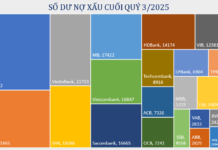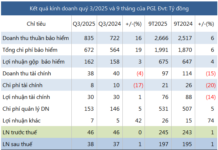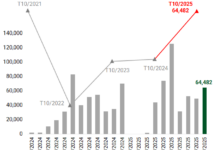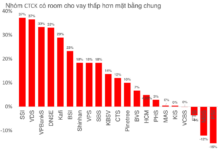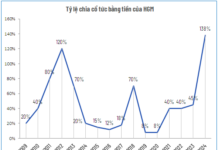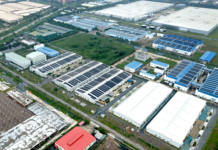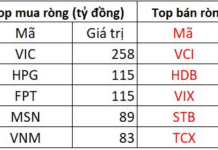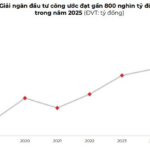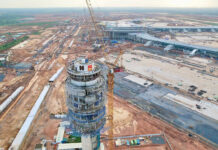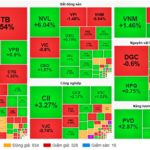Ho Chi Minh City’s transport landscape is about to undergo a significant transformation. Several key infrastructure projects, including the expansion of the Ho Chi Minh City – Long Thanh – Dau Giay Expressway, the new Ho Chi Minh City – Moc Bai Expressway, and the Nguyen Khoai Bridge, are set to break ground in August 2025, promising to alleviate congestion and enhance regional connectivity.
Two Critical Projects to Commence in August
The eastern gateway (An Phu intersection area) and the northwestern gateway (National Highway 22) of Ho Chi Minh City are currently experiencing severe congestion. Container trucks and cargo vehicles often clog these routes, moving slowly and causing prolonged traffic jams, pollution, and increased transportation costs and time. However, relief is on the way.
According to the Ho Chi Minh City Transport Works Construction Investment Management Authority (TCIP), on August 19, 2025, the city will inaugurate the expansion project for the main route of the Ho Chi Minh City – Long Thanh – Dau Giay Expressway, stretching from Ring Road 2 to the Bien Hoa – Vung Tau intersection. This 21-kilometer-long route is a vital link between the city center and Long Thanh International Airport and the southeastern provinces.
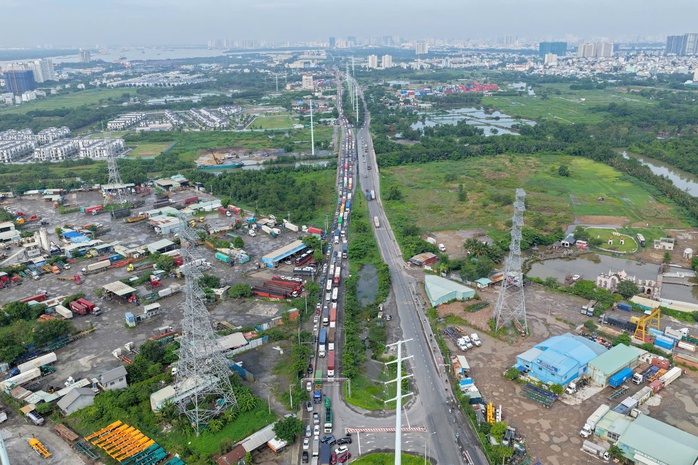
The Ho Chi Minh City – Long Thanh – Dau Giay Expressway towards the An Phu intersection often experiences congestion. Photo: ANH VU
With a total investment of over VND 15,700 billion, the expressway will be widened from four to eight lanes between Ring Road 2 and Ring Road 3, and further expanded to ten lanes from Ring Road 3 to the Bien Hoa – Vung Tau intersection. The project, undertaken by the Vietnam Expressway Corporation (VEC), is expected to be completed by 2026, coinciding with the first phase of Long Thanh International Airport’s operation.
In parallel, TCIP shared that the city is also preparing to launch the expansion project for the expressway’s access road, stretching from the An Phu intersection to Ring Road 2. This 3.2-kilometer-long section currently has only four lanes and often faces congestion. Once completed, the road will be 36 meters wide with eight lanes. The two bridges along this route, Mương Kênh and Đỗ Xuân Hợp, will also be widened accordingly. With a total investment of over VND 915 billion from the city’s budget, the project is expected to break ground in September 2025 and be substantially completed by 2026 to serve the Long Thanh International Airport. Although a separate project, this access road is considered a crucial link in the city’s eastern transport network.
Sharing more good news, TCIP representatives announced that on August 19, 2025, Ho Chi Minh City will also commence the Ho Chi Minh City – Moc Bai Expressway project. This expressway, spanning over 50 kilometers, carries a total investment of more than VND 16,700 billion and will be developed through a public-private partnership (PPP). With its starting point at Ring Road 3 and ending at the Moc Bai border gate in Tay Ninh province, the expressway will feature four lanes and a designed speed of 120 km/h. This route will help decongest National Highway 22 and establish a strategic connection between Ho Chi Minh City and the provinces in the southern key economic region. The groundbreaking ceremony will mark the beginning of activities such as bomb disposal, construction of temporary roads, and relocation of technical infrastructure, with official construction expected to commence in 2026 and completion by the end of 2027.
Upcoming Projects: Nguyen Khoai Bridge and Nga Tu Dinh Intersection
In addition to the expressways, the city administration plans to invest in and upgrade several local roads in 2025 to alleviate traffic in the area.
One highly anticipated project is the Nguyen Khoai bridge and road, which will reduce traffic pressure on Nguyen Tat Thanh Street and improve connectivity between the city center and the south of Ho Chi Minh City. This project has been awaited by residents for over a decade.
According to TCIP, the Nguyen Khoai bridge and road project is expected to commence in early November 2025 and be completed by the fourth quarter of 2027. To date, TCIP has advanced VND 929 billion to the old District 4 Compensation and Site Clearance Board. Compensation payments to residents are underway, and some households have already received compensation, demolished their houses, and handed over the site to the authorities. It is anticipated that compensation and site handover will be completed by October.
With a total investment of over VND 3,720 billion from the city’s budget, the project will also involve the construction of a 1-kilometer-long approach road, a 626-meter-long Nguyen Khoai road, and two roads along Hoang Trong Mau Street, each measuring 222 meters in length. Upon completion, the project will not only reduce traffic pressure in the area but also strengthen the connection between the south of the city and its center.
Another eagerly awaited project is the construction of the Nga Tu Dinh intersection (the intersection of National Highway 1 and Nguyen Van Qua Street). This intersection has complex traffic conditions, frequent congestion, and a high risk of accidents due to the constant flow of vehicles on National Highway 1.
With a total investment of VND 397 billion, the Nga Tu Dinh intersection project will involve the construction of a concrete bridge spanning over 433 meters with four lanes, along with two roads on both sides, each approximately 600 meters long and featuring two to three lanes. Additionally, the turning radius at the intersection’s entrances and exits will be adjusted to ensure better visibility and safer traffic flow.
Where will the Ninh Binh Airport Be Located?
The People’s Committee of Ninh Binh Province has proposed to the Ministry of Construction a number of strategic local transportation infrastructure investments, including the Ninh Binh International Airport project in Lien Truong Ward.
“From ‘Running and Queuing’ to ‘Lined Up, Clear Path, United We Progress”
Vietnam is embarking on an era of Renewal 2.0, a rapid transition from policy statements to tangible outcomes. This is evidenced by the 34 laws passed in June, alongside extensive administrative reforms.









